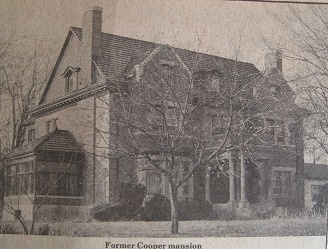NIAGARA STREET MANSION IS STILL STRONG ON CHARACTER
Robert Cooper first owner
[Welland Tribune, 30 November 1984]
Janice Walls-Tribune staff writer
 WELLAND-The Cooper mansion is a fitting monument to am n who came to Welland as a penniless boy and grew to be a wealthy and powerful man.
WELLAND-The Cooper mansion is a fitting monument to am n who came to Welland as a penniless boy and grew to be a wealthy and powerful man.
Located at 201 Niagara St., the unique home was built in 1913-14, for Robert Cooper, an eminent Welland industrialist and politician. It is now owned by the Holy Cross Fathers who use it as their residence.
With elements of Renaissance Revival, the imposing three storey building has an appearance of strength and stability. Constructed of beige brick on a foundation of cur stone, it has an open air porch supported by eight stone Doric columns.
The front entrance is a large moulded trimmed door set within a moulded frame and capped by a shaped transom of leaded glass. It is bordered by two side lights with lower wood panels and carved, wooded Doric columns.
The mansion has a glazed tile roof with a decorative frieze.
The inside of the building is just as impressive as the outside. With the original wooden panelling, high baseboards and door frames still present. There are also five ornate fireplaces and a grand central staircase.
Cooper owned a flour mill on East Main Street near the east bank of the canal. The mill was the headquarters of a large retail trade in flour, meal, buckwheat, mill feed and all types of farm and garden seed.
A book published by this city in 1902 states his mill was classified as a 100 barrel mill and was installed with the best and most modern machinery and fixtures. Cooper’s mill later became the Maple Leaf Milling Co.
Cooper managed his own farm on Thorold Road, which was one of the best in the county, owned Brown Brother’s Aqueduct Roller Mills for a number of years, sold horses (sent to South Africa) and had other business interests.
He was also active in local and provincial politics.
A member of town council in 1886 and 1887, Cooper became deputy reeve and was county clerk in 1891. As county clerk he was said to handle the county council as though it was his own property.
He also served as a member of the Ontario legislature, and held positions in the Children’s Aid Society and the water commission.
The Cooper mansion is one of many historical buildings studied by a research group this summer. The research has been done for the Local Architectural Conservation Advisory Committee, which examines buildings for their historical and architectural merit.
 Subscribe..
Subscribe..
Add A Comment
You must be logged in to post a comment.